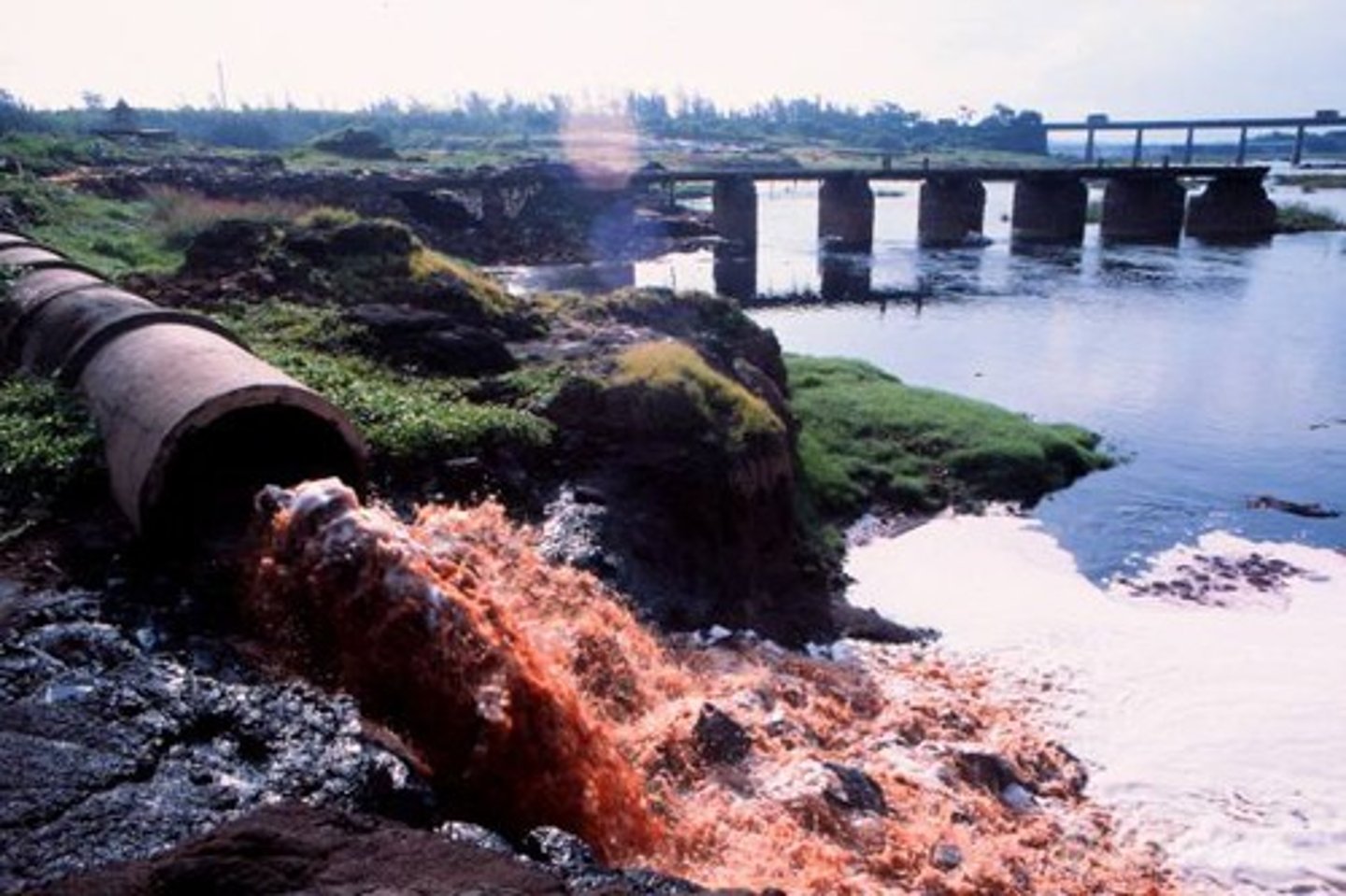APES Exam Review
1/568
Earn XP
Description and Tags
Name | Mastery | Learn | Test | Matching | Spaced |
|---|
No study sessions yet.
569 Terms
How is stratospheric ozone formed?
The interaction of UV radiation (sunlight) and O2
What are the reactions that result in ozone formation?
O2 + UV (sunlight) --> O + O; O + O2 --> O3
What was the cause of declining ozone levels?
Chlorofluorocarbons (CFCs)
What are CFCs used for?
Refrigerants, coolants, aerosol propellants, industrial solvents
Why do CFCs cause declining ozone levels?
Migrate to stratosphere because they are stable; UV radiation breaks CFC apart and releases chlorine atoms
What do chlorine atoms do?
Form chlorine monoxide while converting O3 to O2, Cl + O3 --> ClO + O2
How does ozone loss harm ecosystems?
UV rays can kill phytoplankton and primary producers; animals without protective fur or skin directly harmed
How does ozone loss harm humans?
Increased UV exposure can lead to cataracts, skin cancers, and weakened immune systems
When was the Montreal Protocol signed, and what did it do?
1987; called for end of CFC production and phased out CFCs for less harmful alternatives
Has the US stopped producing CFCs?
Yes, in 1995
What are halocarbons and halons?
Types of CFCs; used as fire retardants, pesticides, and foam insulation
What is the greenhouse effect?
Greenhouse gases in the troposphere absorb the infrared heat radiating from the earth and heat the lower atmosphere
What are the major greenhouse gases?
Water, Carbon dioxide, Methane, Nitrogen dioxide, CFCs, Tropospheric ozone
What are the greenhouse gases by warming potential?
CFCs, Nitrogen dioxide, Methane, Water vapor, Carbon dioxide (ozone is not specific)
What is the source and remediation for water vapor?
Natural; little that can be done to control it
What is the source and remediation for carbon dioxide?
Burning fossil fuels; move energy sources from fossil fuels to renewables, carbon sequestration
What is the source and remediation for methane?
Livestock, anaerobic respiration in swaps and landfills; capture and burn as natural gas, quick to degrade = noticeable effect immediately
What is the source and remediation for nitrogen dioxide?
High Temp combustion = automobiles; electric/hybrid cars
What is the source and remediation for CFCs?
Anthropogenic = refrigerants; Montreal Protocol banned but will still affect atmosphere = stay for long time
What is the source and remediation for ozone?
Photochemical smog from autos, burning biomass, and industry; reduce emissions of smog gases (NOx, SO2) and particulate matter by having catalytic converters on cars and smokestack scrubbers
Why are there yearly fluctuations in CO2 levels?
During summer/wet season = more photosynthesis in Northern Hemisphere, During winter/dry season, less photosynthesis in Northern Hemisphere
Why does clear-cutting increase CO2 levels?
Reduction of CO2 uptake by plants, burning logs releases carbon
What do ice core data show about climate change?
Correlation between CO2 conc. and air temp., temperature increase may be highest in 400,000 years
What do historical data show?
Global temperatures have increased by 0.5C in 100 years, temp could increase by 4C in 100 years
What is the major cause of sea level rise?
Thermal expansion of oceans
How will melting ice affect sea levels?
Land-based ice will increase sea levels, sea-based ice will not
How will sea level rise affect estuaries and coastal ecosystems?
Loss of wetlands, marshes, and intertidal zones = decline or loss of species
How many humans live within 60 miles of a coastline?
40%
How will rising water affect coastal communities?
Severely = loss of property from land erosion, loss of fish/shellfish from estuary flooding, loss of tourism from beach loss, loss of freshwater from saltwater intrusion, conflict from migration
What are examples of large river systems?
Colorado in USA and Yangtze in China
What will climate change do to river systems?
Increased melting of snow pack = greater flow in short term, eventually no snow pack to supply river
What would increased precipitation do?
More surface water/groundwater, increased erosion and sedimentation
What would decreased precipitation do?
Reduce surface water/groundwater, decrease erosion and sedimentation
What will happen to biomes due to climate change?
Warm biomes likely to expand toward poles
What will happen as more water vapor is in the atmosphere?
Change in precipitation
Which species will be badly affected by biome loss?
Specialist species
What will happen to insect species with the climate changes?
Ranges will grow = warmer and rainier, diseases and crop damage will spread
What is the albedo effect's application?
Ice = high albedo, water and land = low albedo, melting of ice is a positive feedback loop
What and when was the Kyoto Protocol?
1997; nations promised to reduce greenhouse gas emissions, but no real progress
Why did the Kyoto Protocol lose support?
United States said it would not sign, Australia did not sign
What further meetings and agreements have occurred?
Copenhagen Climate Summit 2009, Paris Climate Agreement 2016 (pledges), UN Climate Change Conference (COP21)
Why is genetic diversity beneficial?
1. Resistance to disease; 2. Tolerance in the face of ecological change
What are the 3 types of biodiversity?
Genetic, species, and ecosystem diversity
What is an example of a genetic bottleneck?
African cheetah; bottleneck from last ice age about 10,000 years ago; current cheetahs are inbred
How is species diversity measured?
Species richness and species evenness (relative abundance)
What is an example of ecosystem diversity?
Everglades National Park in Florida
Why is biodiversity important?
1. Interconnectedness of life; 2. Future resources; 3. Aesthetic value
What are characteristics that make species vulnerable to extinction?
Specialist species, k-strategist(large, low br), Perceived as a pest, Biomagnification, Valuable
What are examples of specialist species?
Feeding = giant panda, Symbiotic relationships = plants with adapted flowers
HIPCO
Habitat loss, Invasives, Climate change, Overharvesting/exploitation, Pollution
What does the Endangered Species Act do?
Habitat protection, ban on disturbing activity, ban on import or export of org/prod of endangered species
TERM
Effluent
DEFINITION
Pollution discharged into water is called effluent
TERM
carbon sink
DEFINITION
A carbon sink is a natural or artificial reservoir that accumulates and stores some carbon-containing chemical compound for an indefinite period : ocean, forests
TERM
Carbon sequestration
DEFINITION
The long term removal of carbon dioxide (CO2) from the atmosphere is known as carbon sequestration: ocean deeps, old oil wells.
RCRA (Resource Conservation and Recovery Act)
Management of non-hazardous and hazardous solid waste including landfills and storage tanks. Set minimal standards for all waste disposal facilities and for hazardous wastes. Cradle to grave
CERCLA (Superfund)
Established federal authority for emergency response and clean-up of hazardous substances that have been spilled, improperly disposed, or released into the environment
Clean Air Act of 1970
Required EPA to develop and enforce regulations to protect the public from airborne contaminants; forced states to follow and make sure the laws for followed in relation to the EPA. States allowed to decide officials for enforcement.
Clean Water Act of 1972
Law intended to clean up the nation's rivers and lakes.
Safe Drinking Water Act (1974)
set maximum contaminant levels for pollutants in drinking water that may have adverse effects on human health
CITES
A 1973 treaty formed to control the international trade of threatened plants and animals
Delany Clause (1958)
protects from cancer causing agents in additives in food and cosmetics
Endangered Species Act
a 1973 U.S. act designed to protect species from extinction
Independent Variable (IV)
the variable that a researcher actively manipulates, and if the hypothesis is correct, will cause a change
Dependent Variable (Responding Variable)
the variable that is observed during the experiment, it is usually measured and data collected from it.
non-point source pollution
Are diffused and can therefore be difficult to identify, such as pesticide spraying and urban runoff.
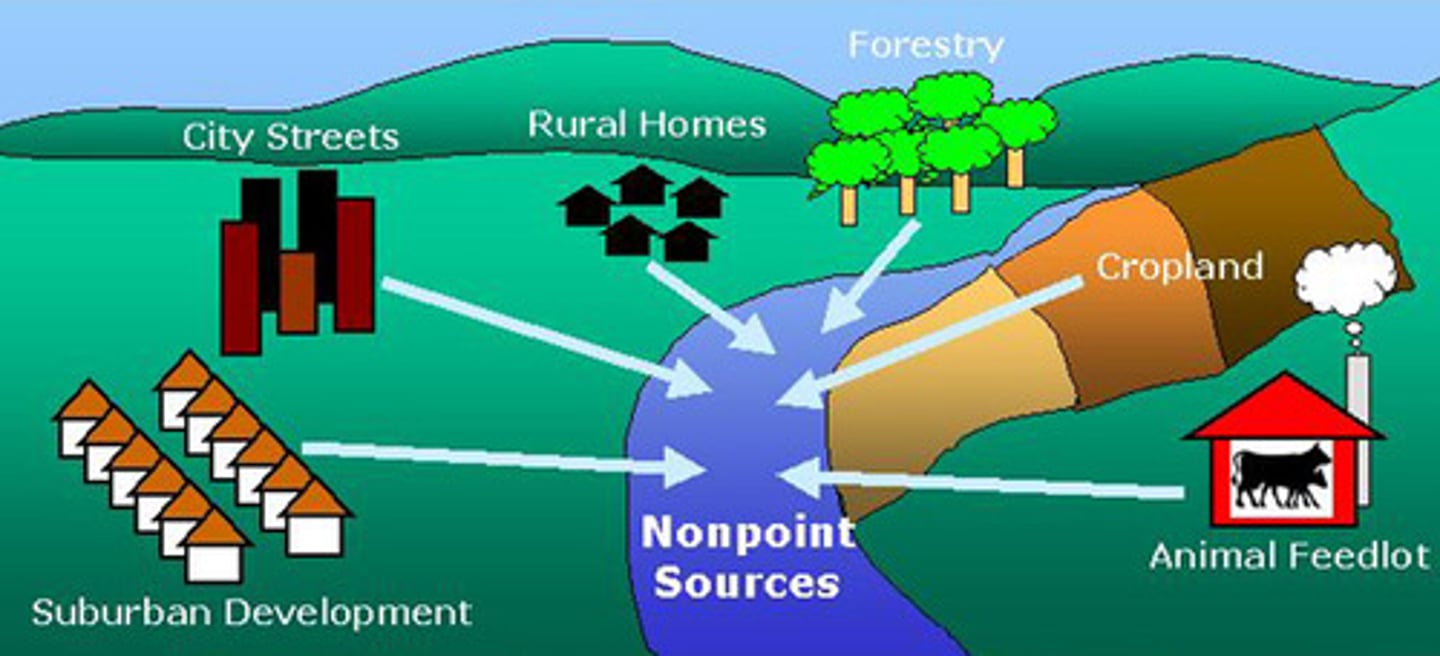
point source pollutant
Single, identifiable source of pollutant, such as a smokestack or waste disposal discharge pipe.
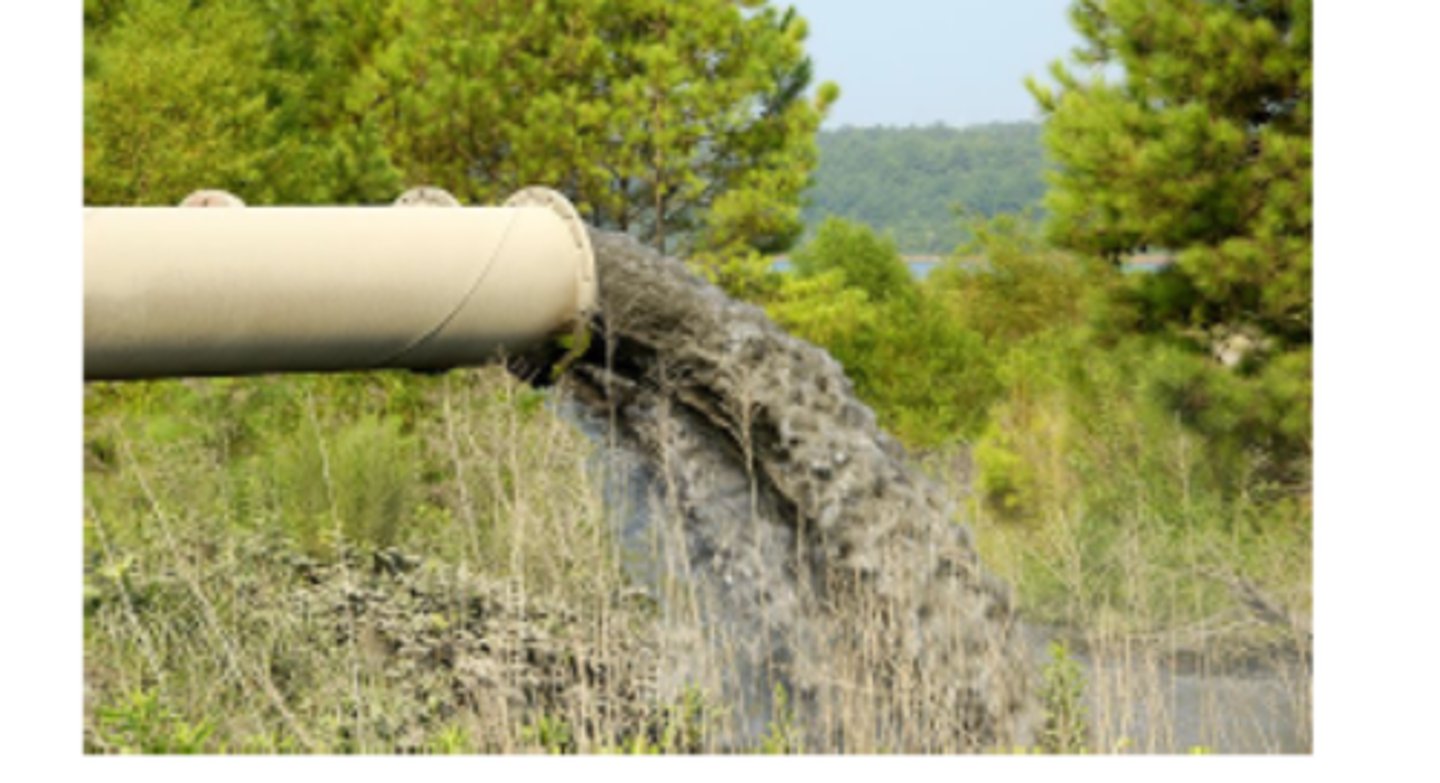
range of tolerance
the limits to the abiotic conditions that a species can tolerate
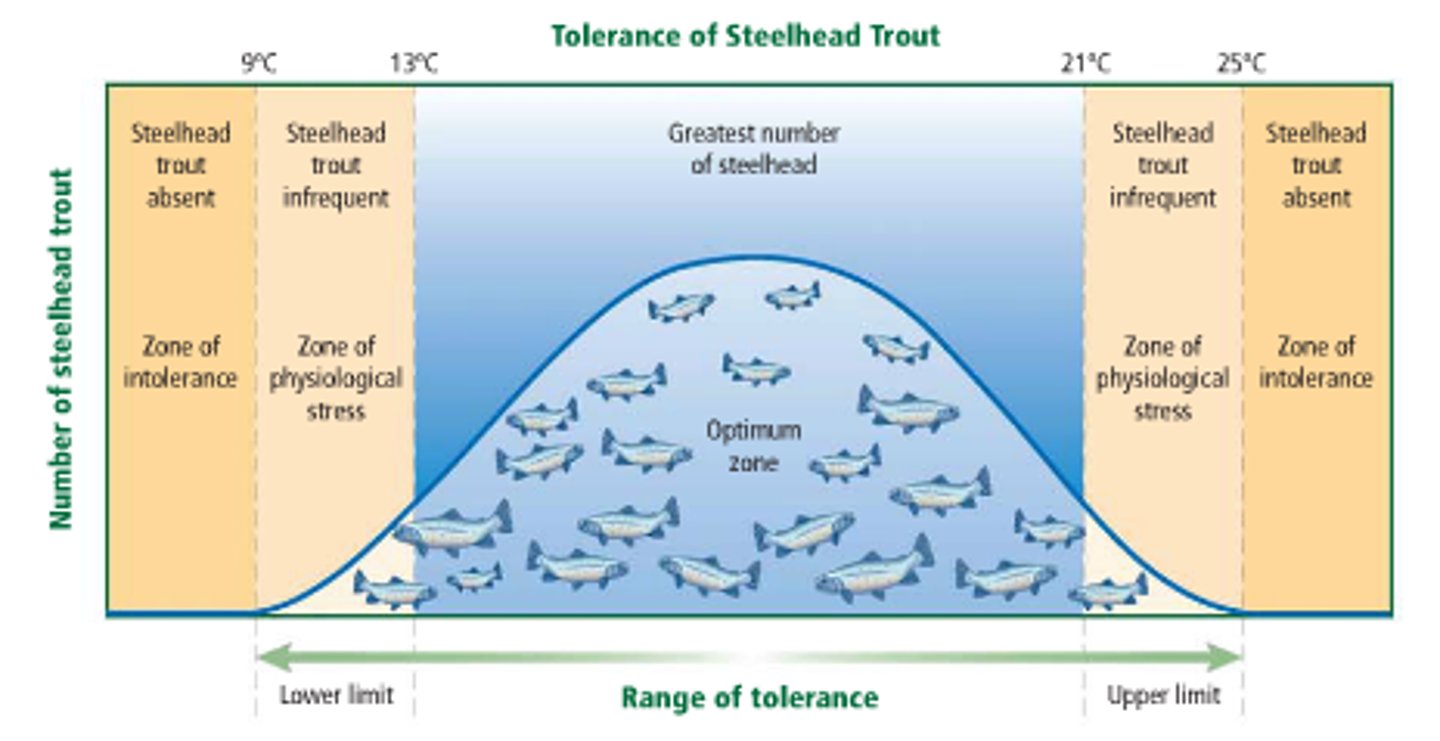
oxygen sag curve
is a plot of dissolved oxygen levels versus the distance from a source of pollution.
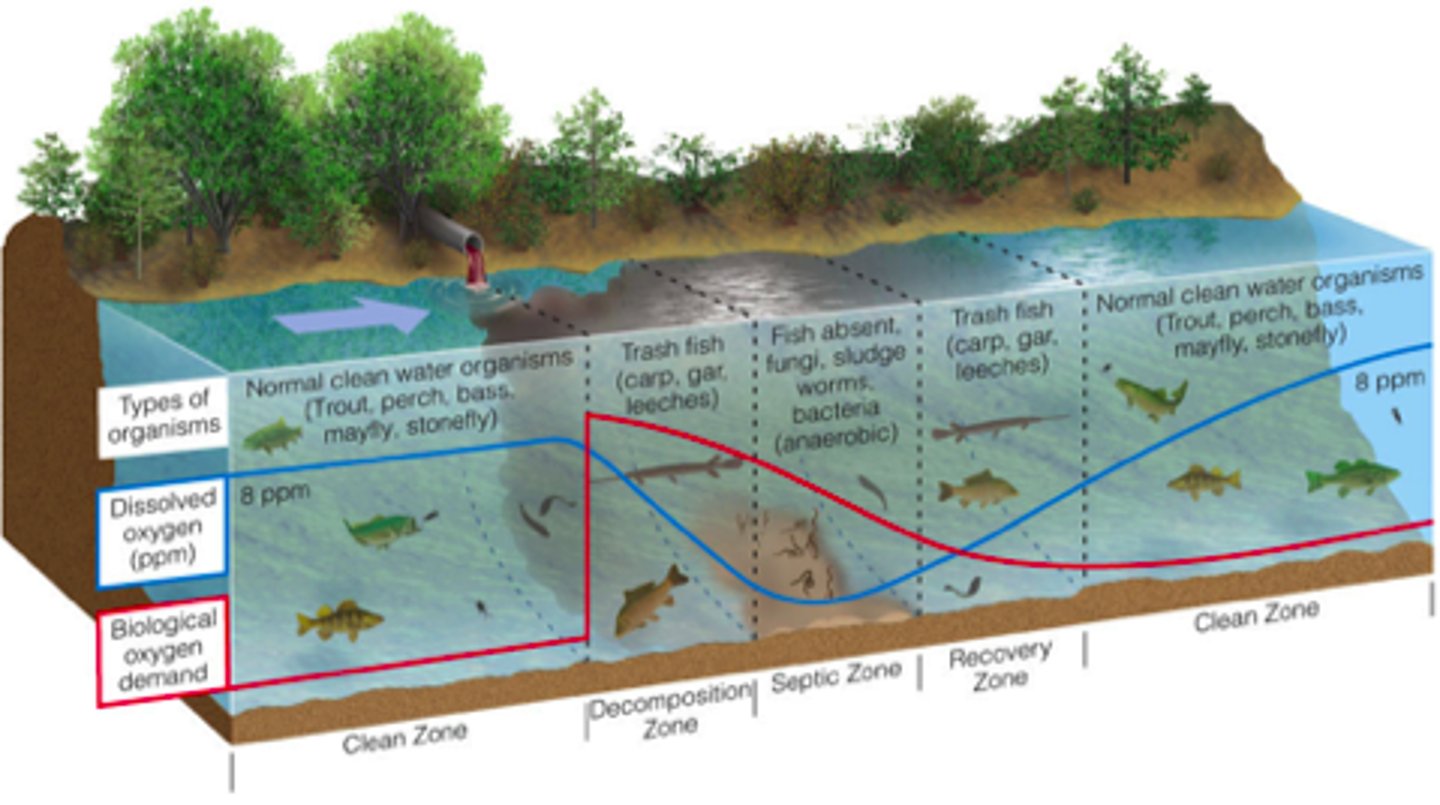
Oil Spill Mitigation Strategies
Clean up, burning, physical removal, chemical dispersants.
endocrine disruptors
chemicals that interfere with endocrine (hormonal) systems of animals. Endocrine disruptors bind to cell receptors meant for natural hormones, either blocking or amplifying the effects of the hormone.
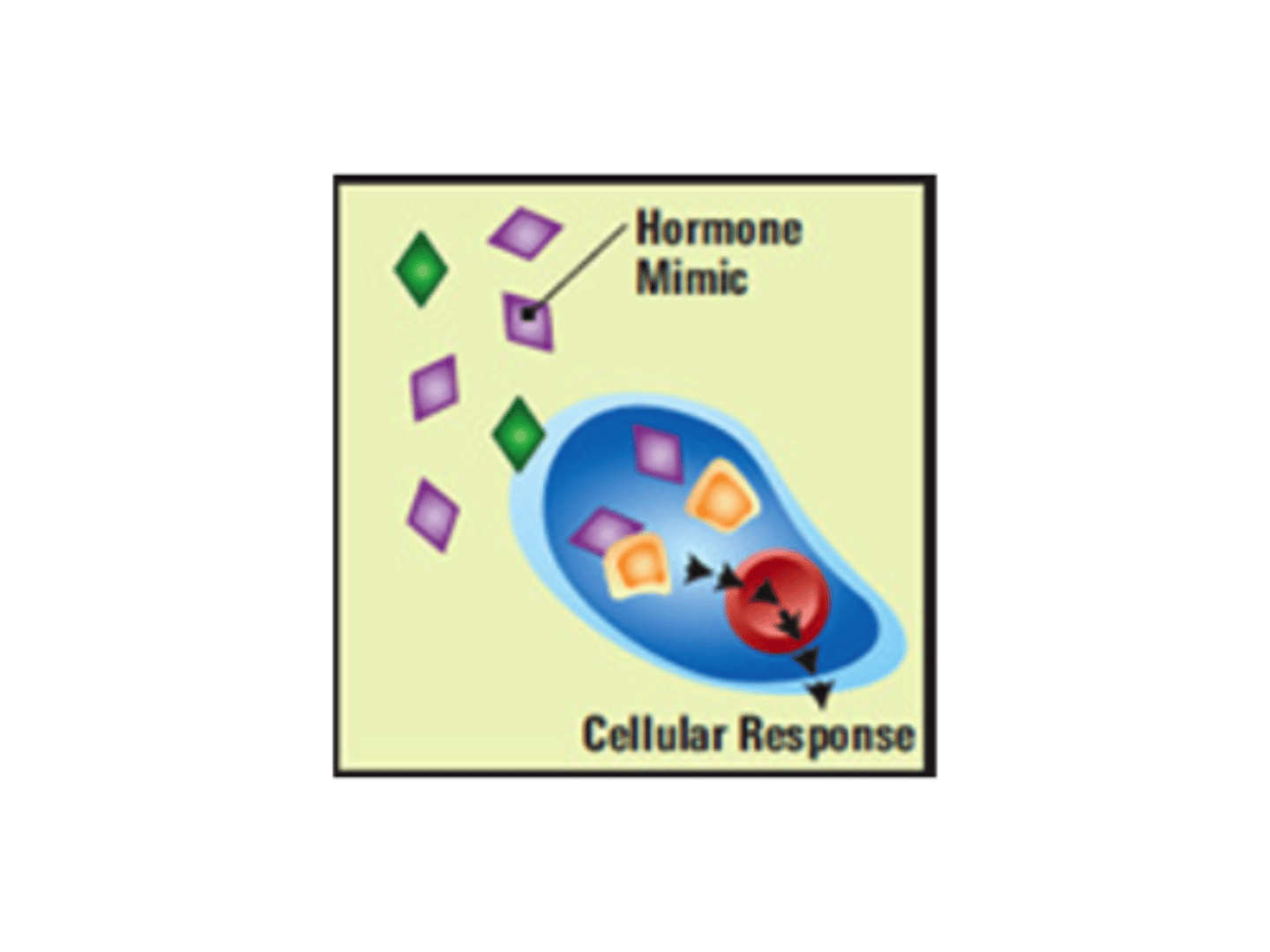
Arsenic
a naturally occurring chemical element, found naturally in bedrock, used in the production of pesticides and wood preservatives, and causes poisoning
Lead
found in paint and its a neurotoxin and endocrine disrupter.
Wetlands
Areas with soil submerged/saturated plants in water for at least part of the year, but shallow enough for emergent plants.
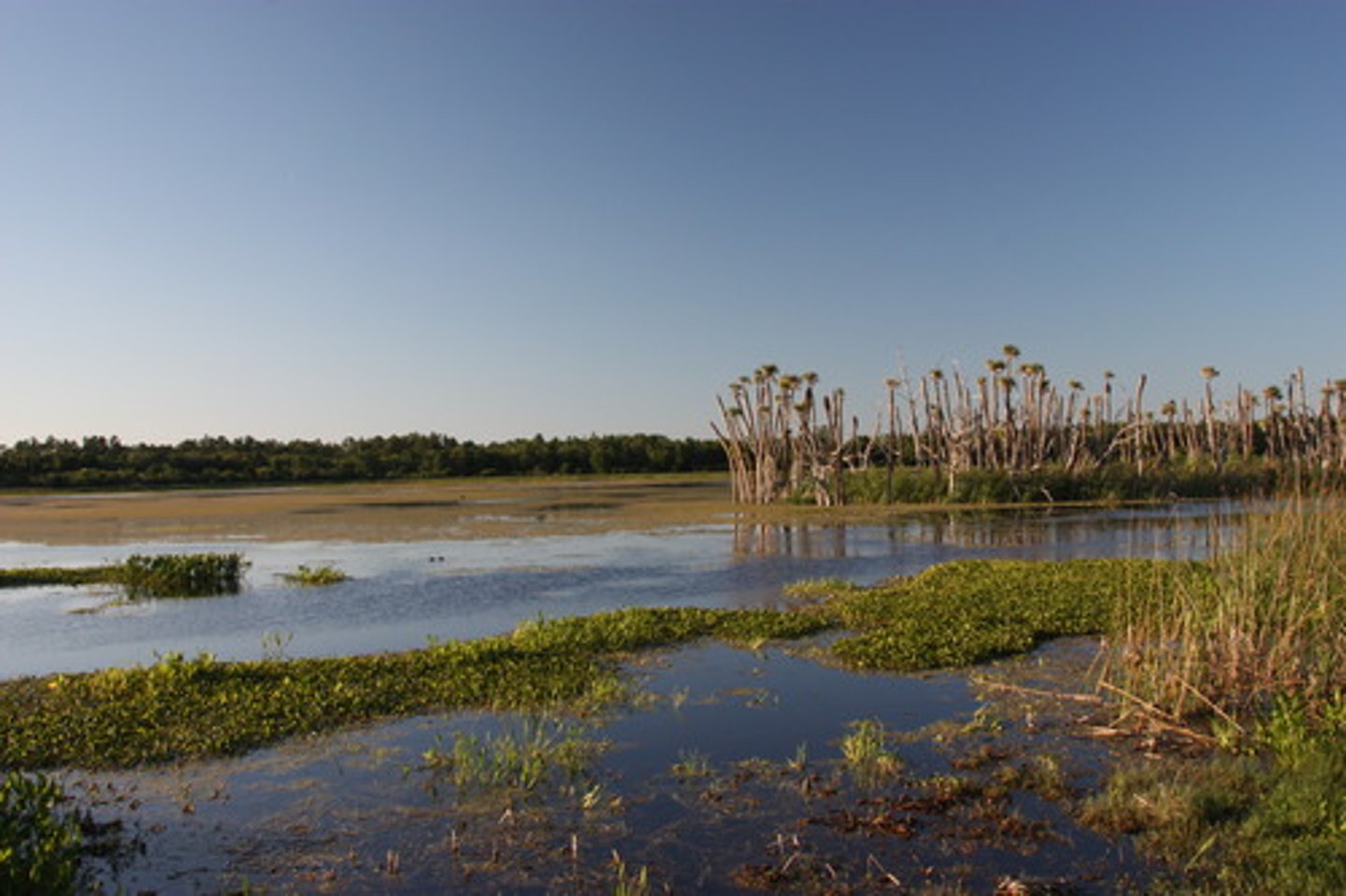
ecosystem services
provisioning, regulating, supporting, cultural
provisioning services
products obtained from ecosystems
regulating services
benefits obtained from regulation of ecosystem processes
cultural services
The non-material benefits people obtain from ecosystems through recreation and aesthetic experience, etc.
supporting services
ecosystem services "that are necessary for the production of all other ecosystem services" - nutrient dispersal and cycling, seed dispersal, primary production
Hypoxic
low oxygen environment
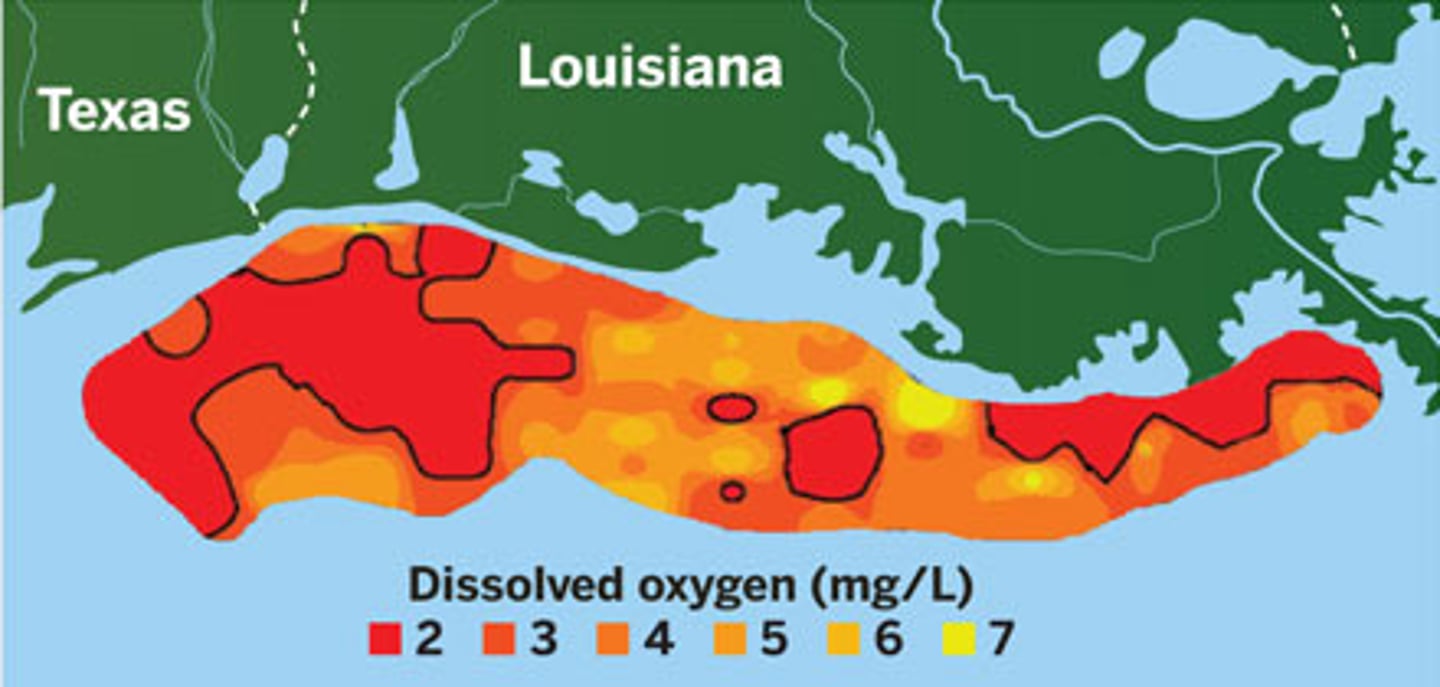
Eutrophic
A body of water with high nutrients
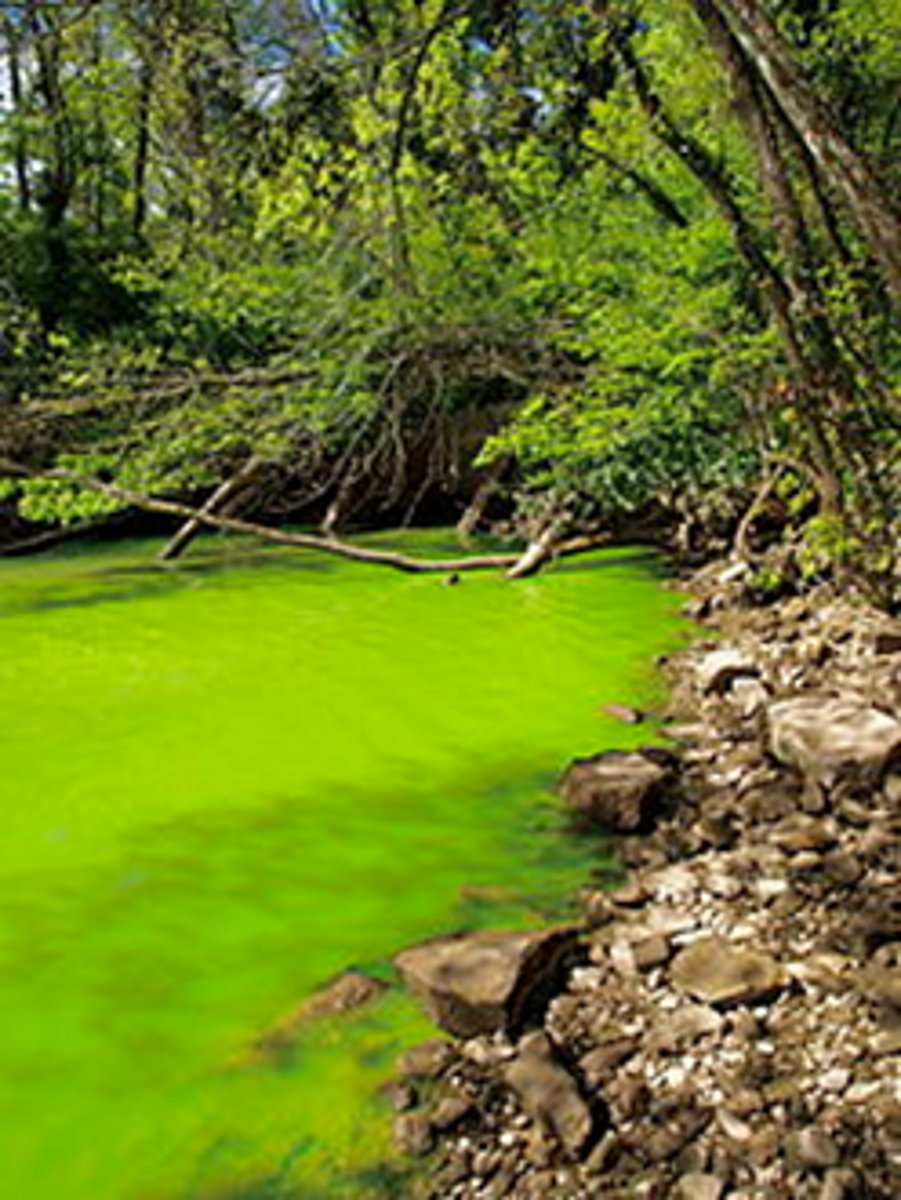
dead zone
In a body of water, an area with extremely low oxygen concentration and very little life.
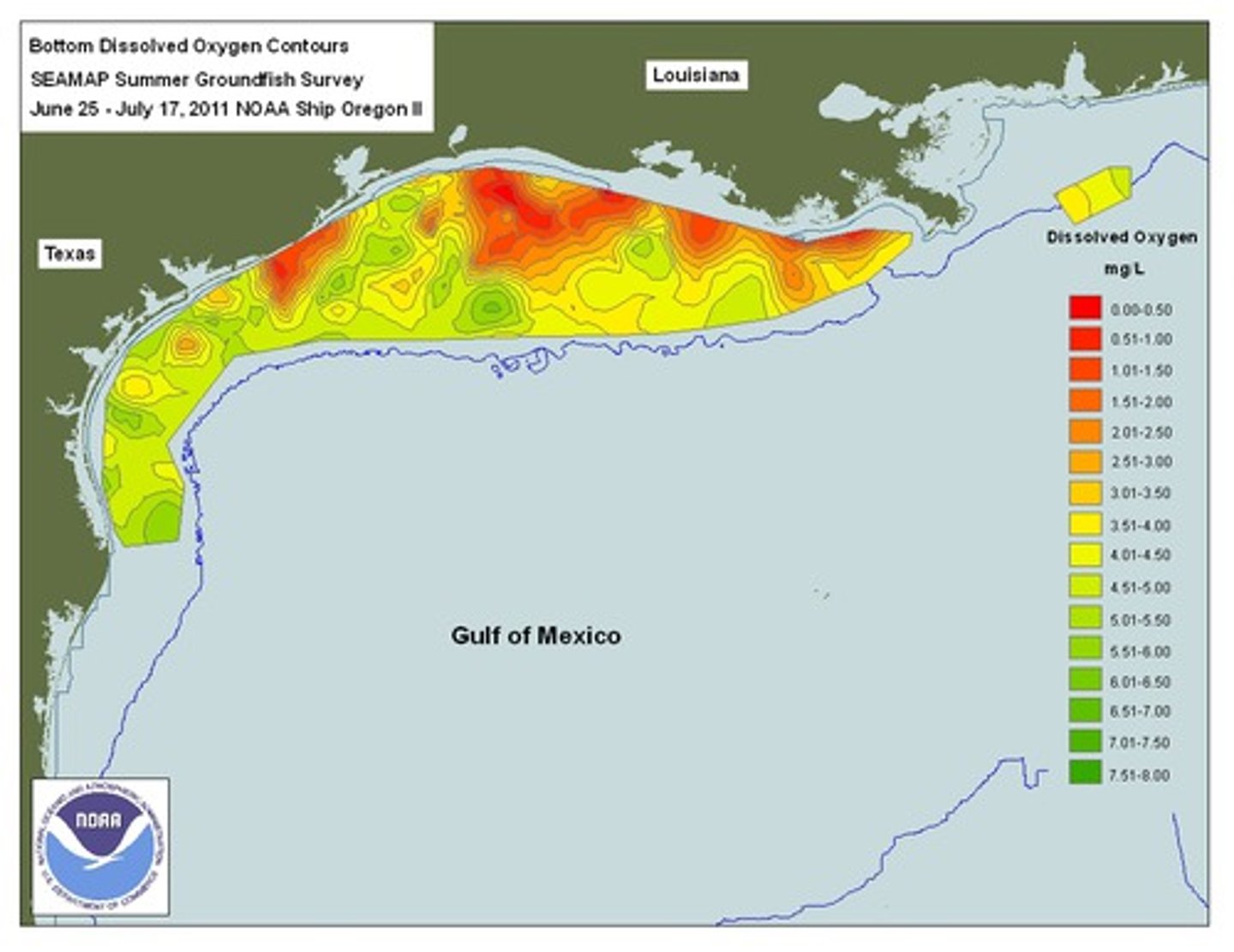
Oligotrophic
A body of water that is low in nutrients and high in dissolved oxygen.
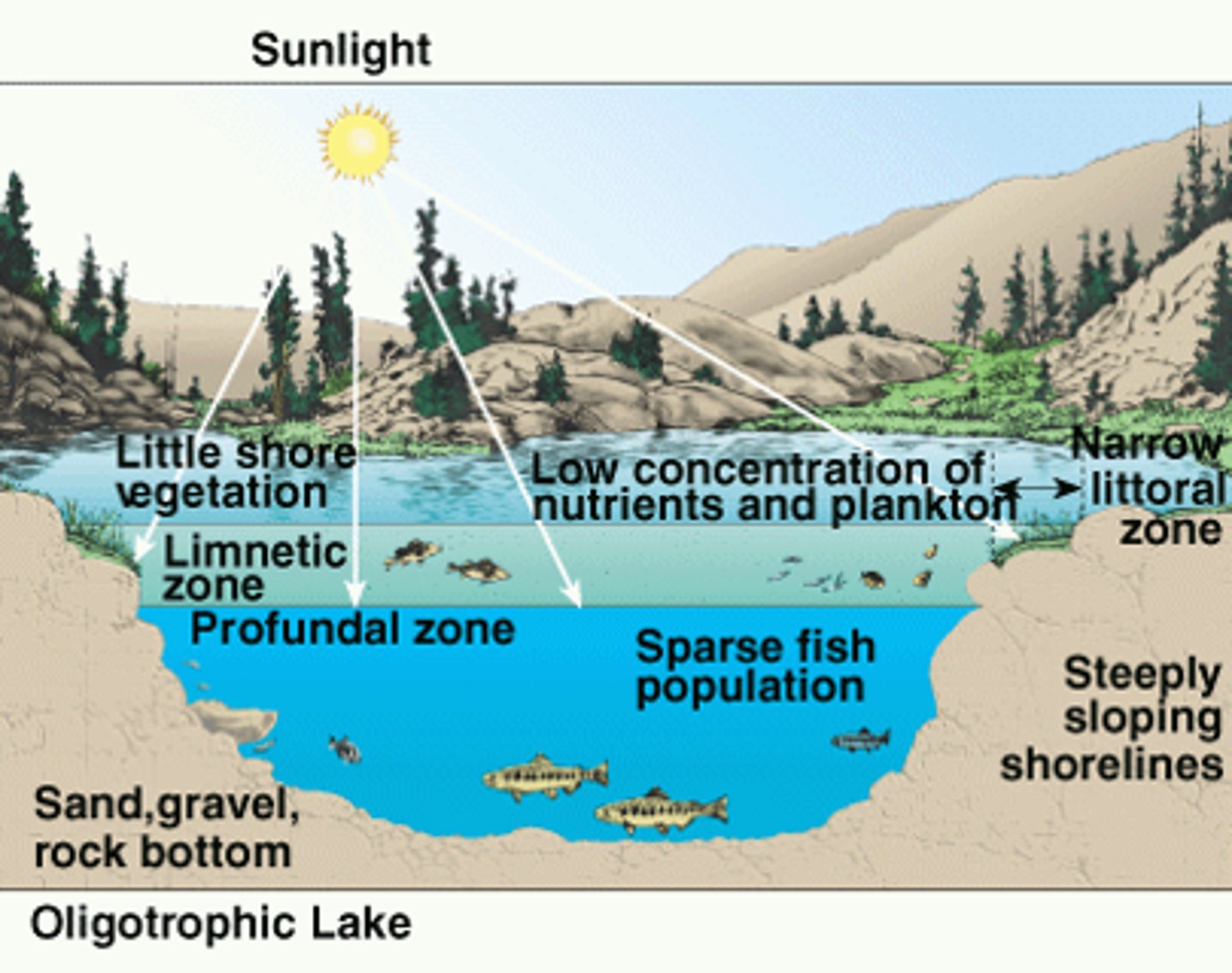
algal bloom
The rapid growth of a population of algae
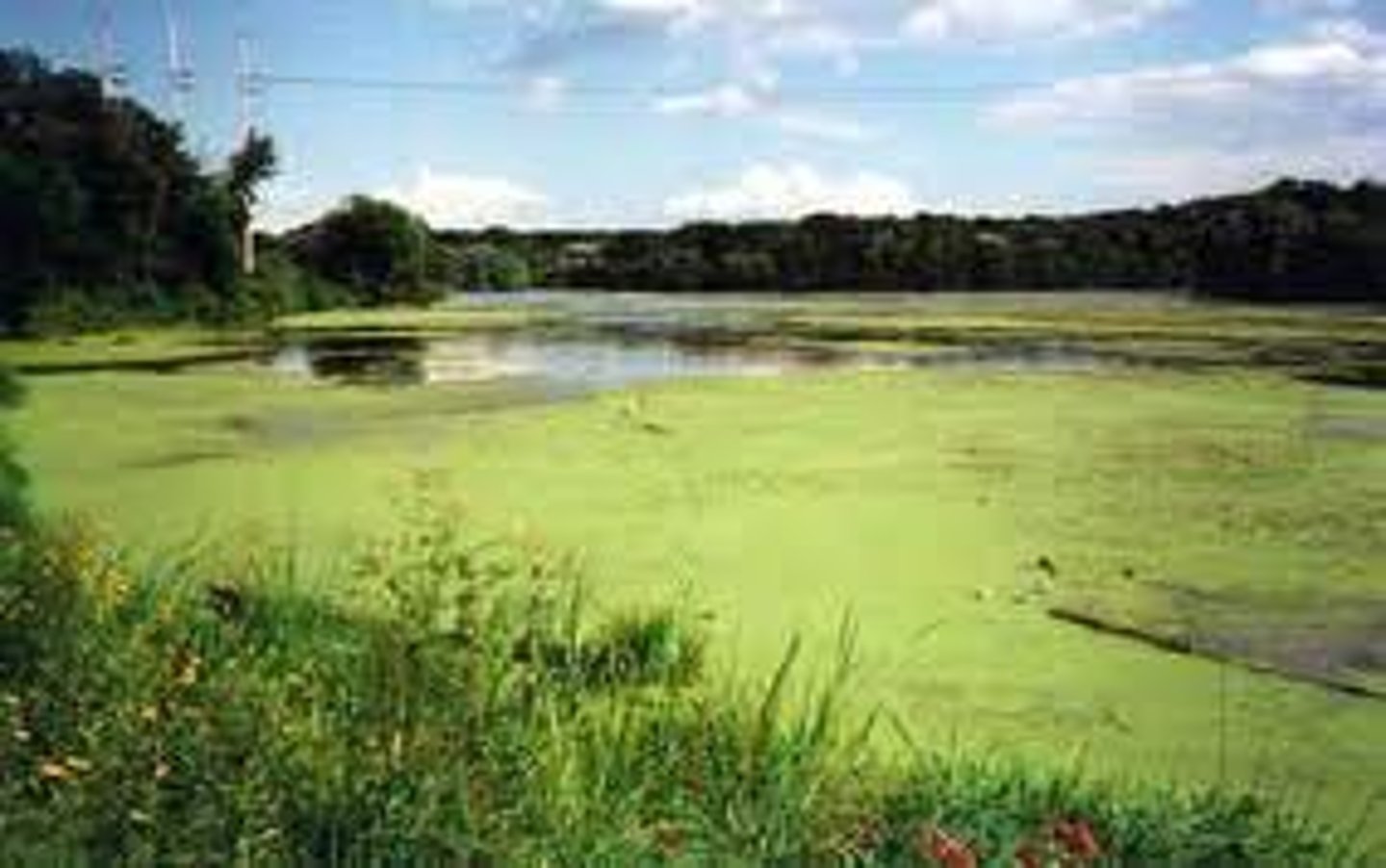
Biological Oxygen Demand
amount of dissolved oxygen needed by aerobic decomposers to break down organic materials
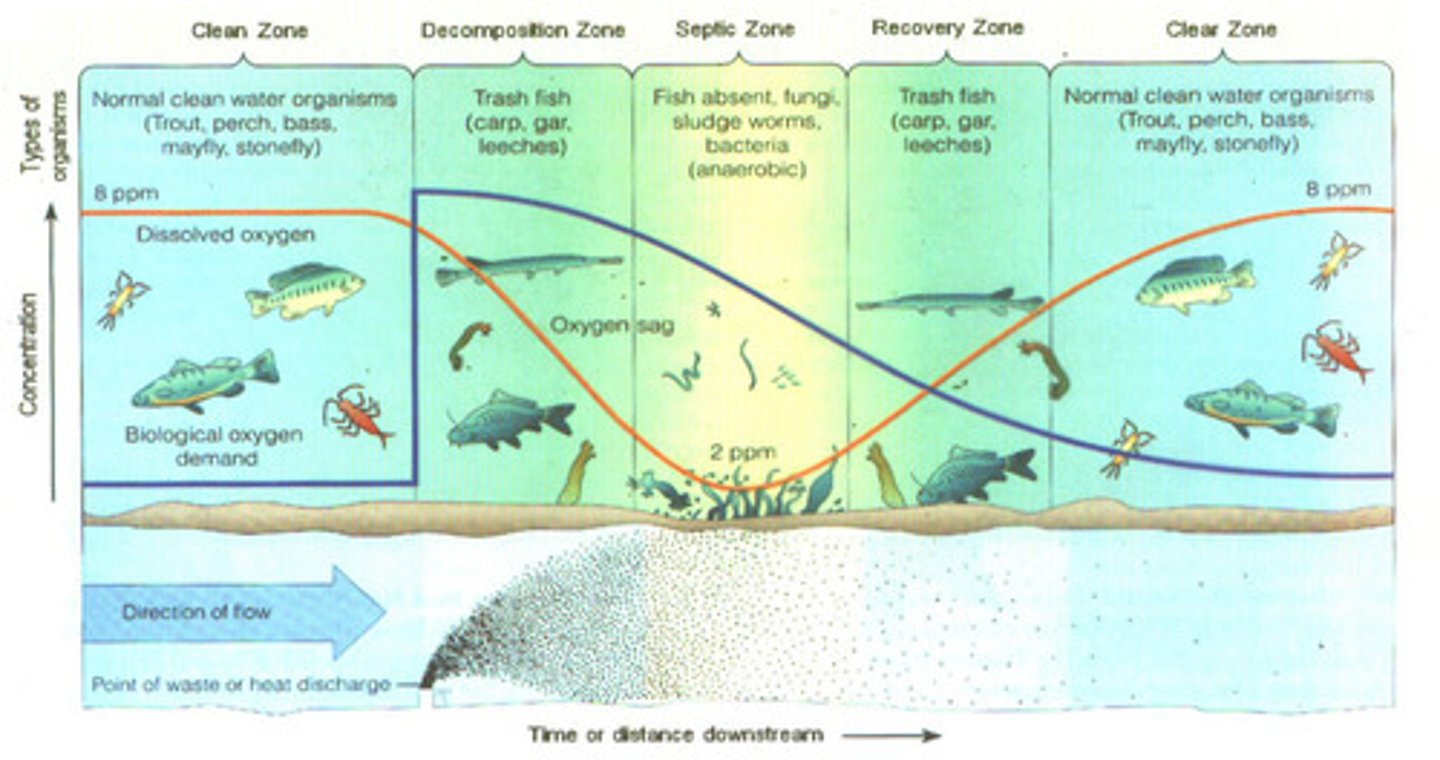
Eutrophication process
Nutrients into water
Increased plankton (algae) - GPP - algal blooms blanket water surface - increase in total biomass - increase in dead organic matter - increase in BOD - decline in O2 levels
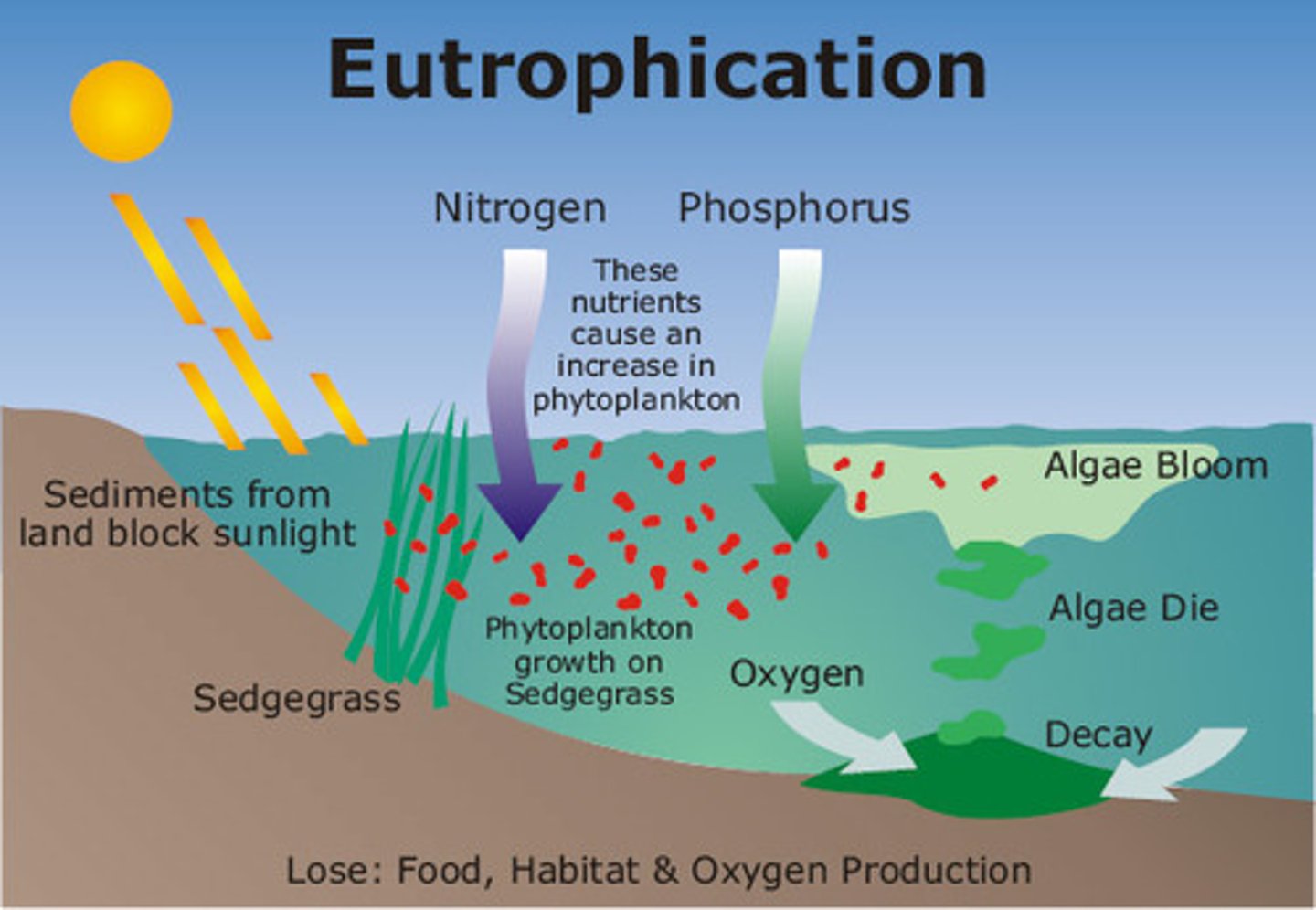
cultural eutrophication
is the process that speeds up natural eutrophication because of human activity. Sediments accumulate over time in the benthic zone.
Thermal pollution
is a sudden increase or decrease in temperature of a natural body of water by human influence.
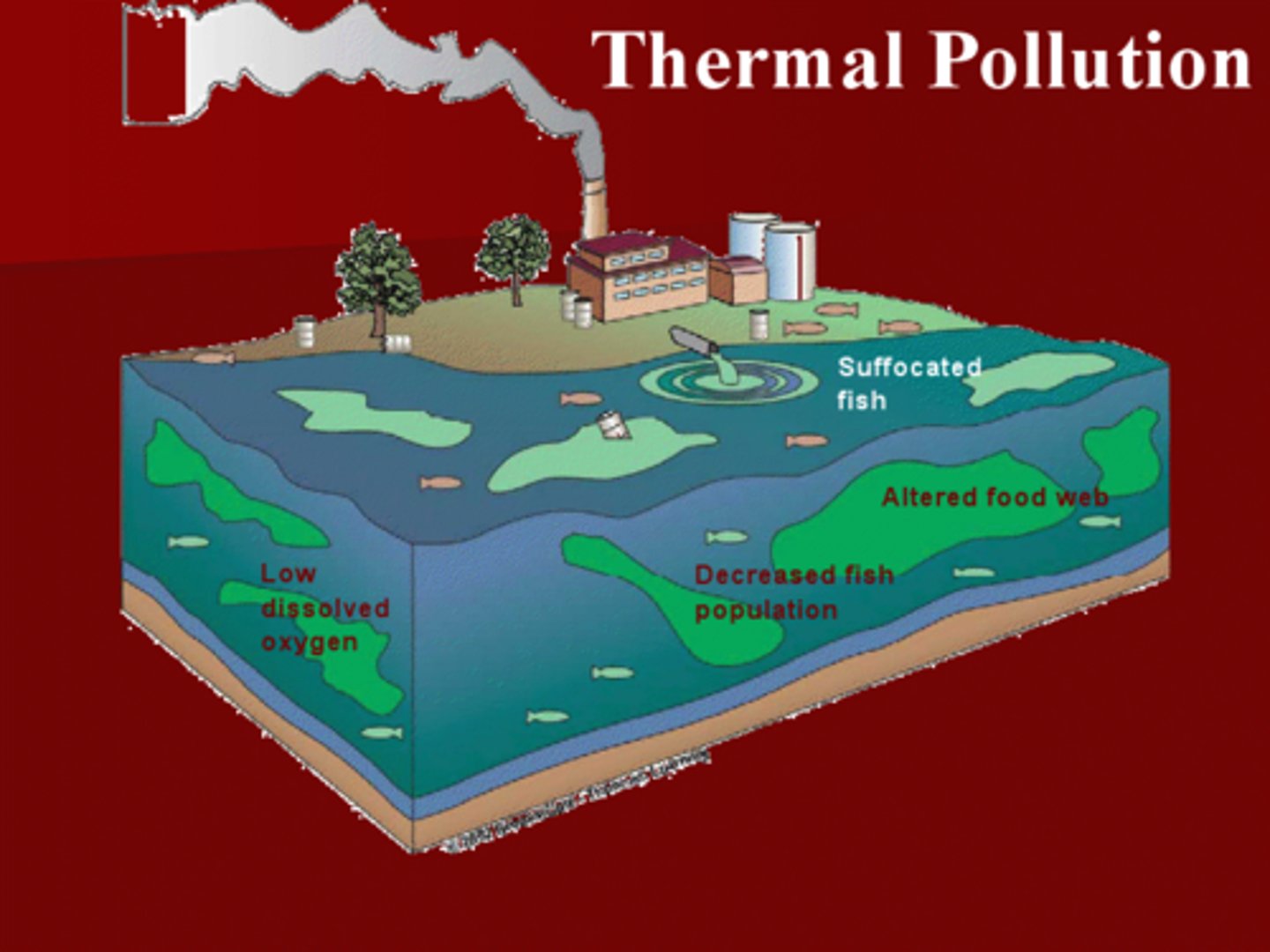
persistent organic pollutants (POPs)
Chemical compounds that persist in the environment and retain biological activity for a long time.
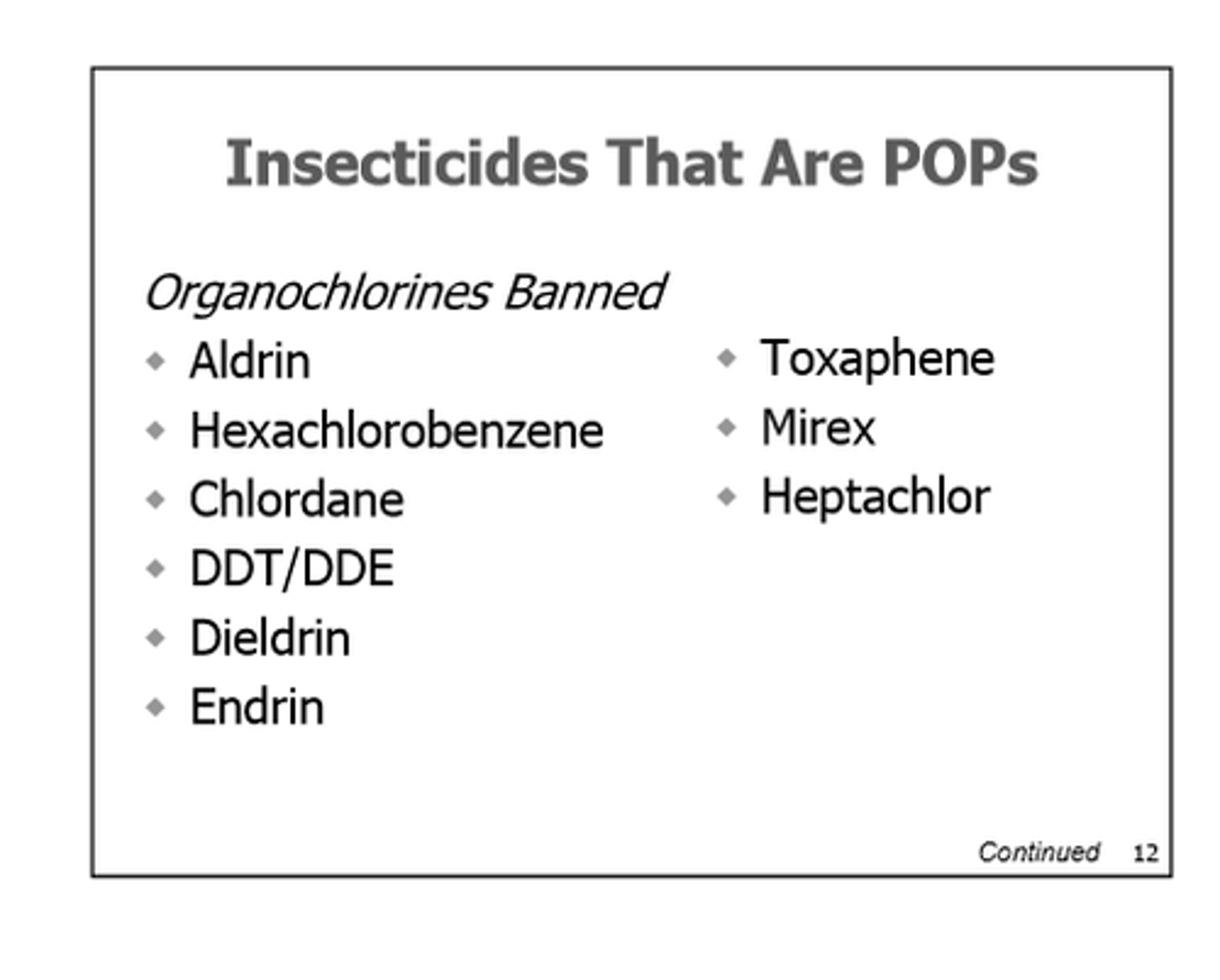
Characteristics of POPs
Persistent, toxic, synthetic, hydrophobic, etc.
DDT
an insecticide that is also toxic to animals and humans

PCBs
synthetic chemicals containing chlorine that are used in the manufacture of plastics and other industrial products, become stored in the tissue of animals, and also persist in the environment
Clean Air Act
Set emission standards for cars, and limits for release of air pollutants
Clean Water Act of 1972
Establishes and maintains goals and standards for U.S. water quality and purity. It has been amended several times, most prominently in 1987 to increase controls on toxic pollutants, and in 1990, to more effectively address the hazard of oil spills.
Safe Drinking Water Act (1974)
Establishes drinking water standards for tap water safety, and requires rules for groundwater protection from underground injection; amended in 1986 and 1996. The 1996 amendments added a fund to pay for water system upgrades, revised standard: setting requirements, required new standards for common contaminants, and included public "right to know" requirements to inform consumers about their tap water.
Resource Conservation and liability act (1980)
to address the problem of remediating abandoned hazardous waste sites, by establishing legal liability, as well as a trust fund for cleanup activities.
Comprehensive Environmental Response, Compensation, and Act (1976)
to clean up uncontrolled or abandoned hazardous-waste sites as well as accidents, spills, and other emergency releases of pollutants and contaminants into the environment. And the transportation of the hazardous waste
Bioaccumulation
The accumulation of a substance, such as a toxic chemical, in various tissues of a living organism.
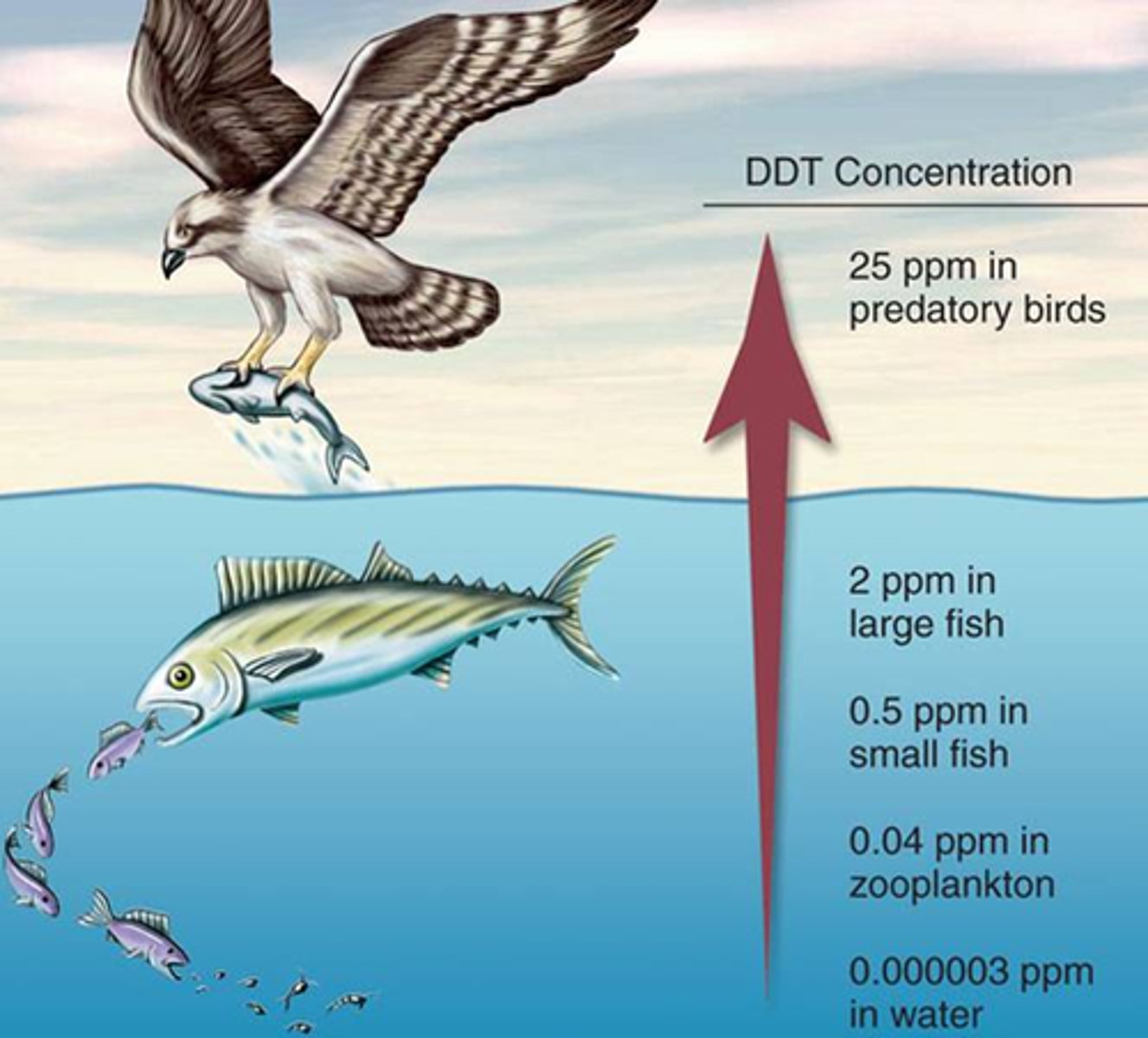
Biomagnification
accumulation of pollutants at successive levels of the food chain
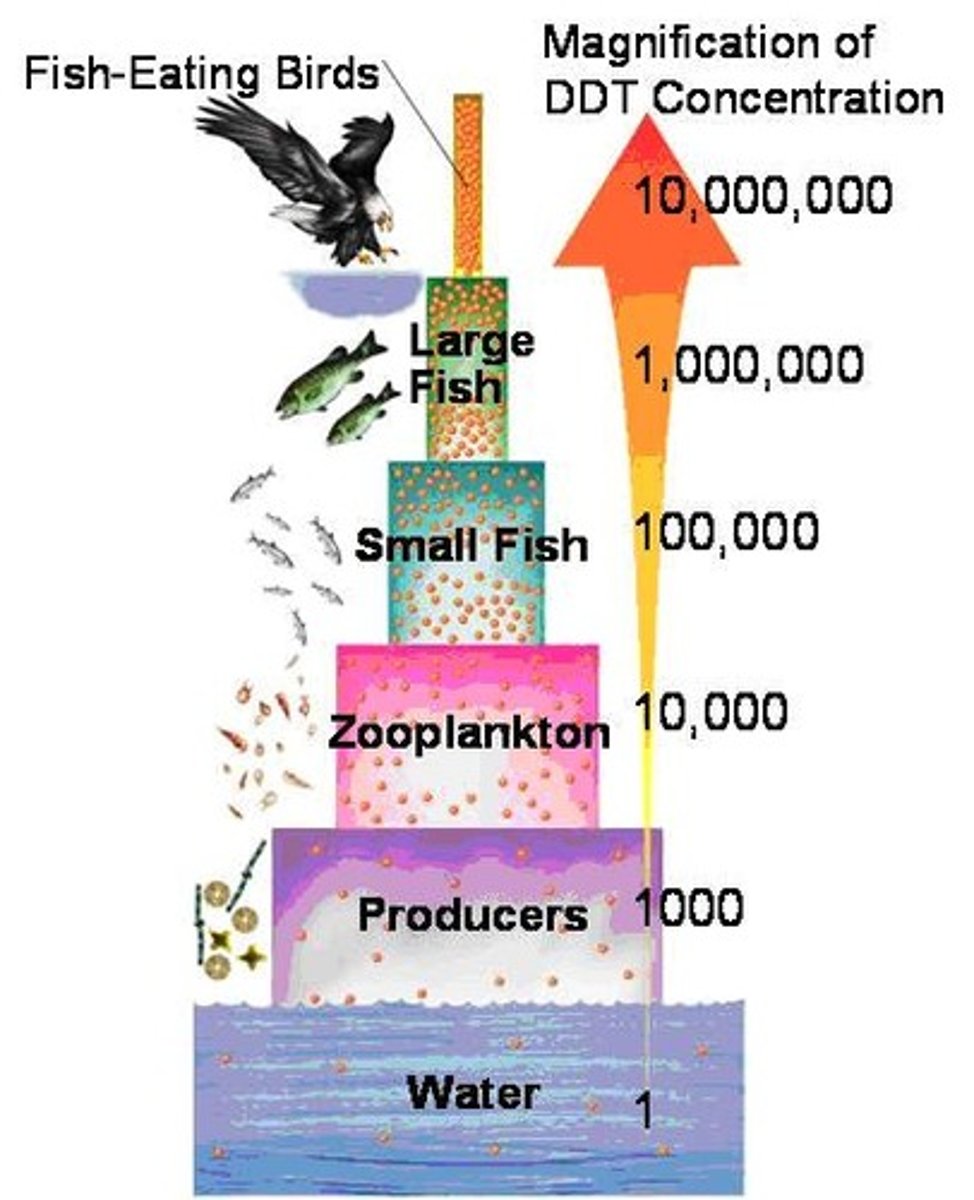
Steps of wastewater treatment/sewage treatment
-Primary(physical removal of large debris)
-Secondary(biological breakdown of organic matter)
-Tertiary(chemical process of removing remaining pollutants)
-Disinfection(treated water is exposed to disinfectants)
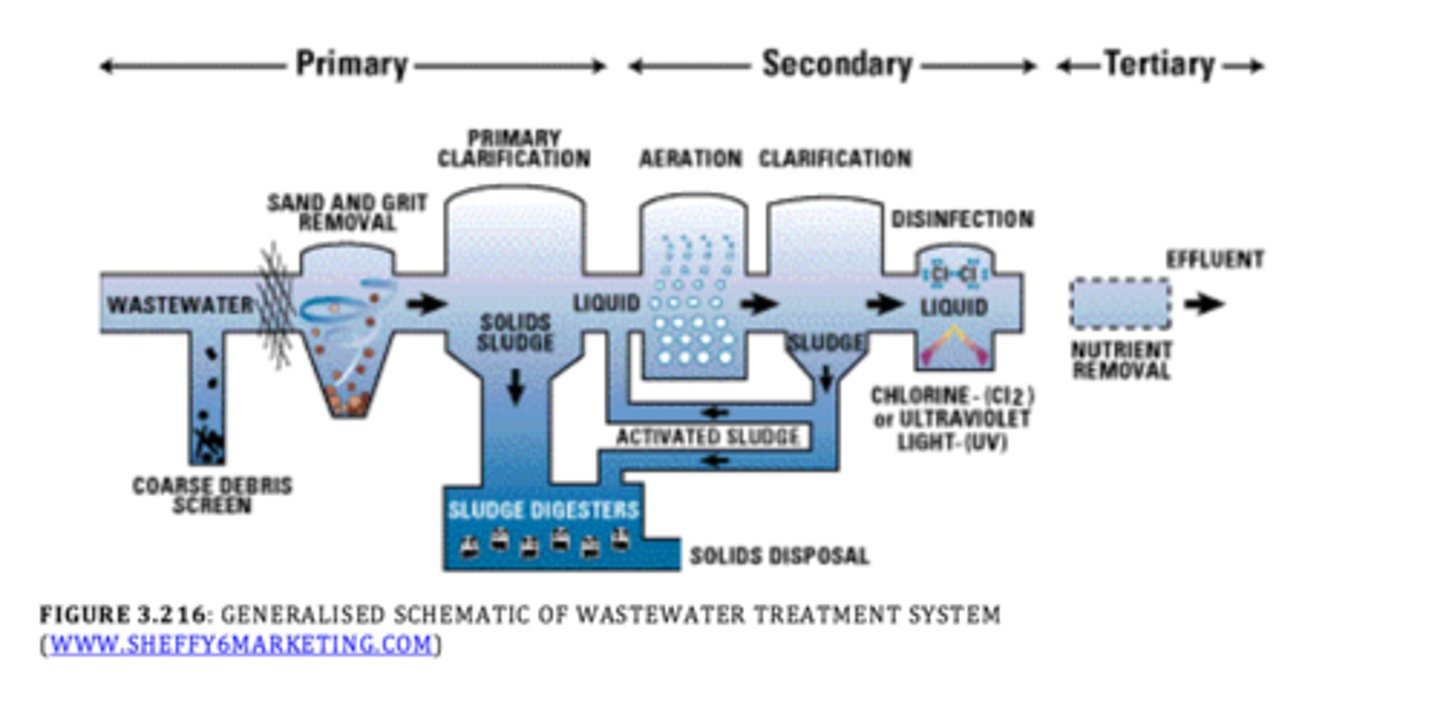
effluent
liquid waste or sewage discharged into a river or the sea.
